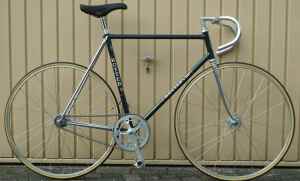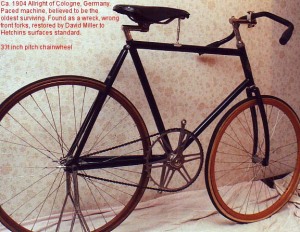Zelf ben ik ook een materiaalliefhebber eerste klas, maar ik heb een hekel aan aanhangers en verkondigers van de enige echte waarheid. In elke theorie schuilt wel een stuk waarheid, ook in twee theorieën, die elk het tegenovergestelde beweren.
Zo ook de keus voor brede of smalle kettingen, kettingwielen en kransjes voor de baanfiets.
Grof gezegd zijn er twee maatvoeringen: 1/8" (breed) en 3/32" (smal).
De brede 1/8" ketting is zo'n beetje de standaard maat voor fietskettingen, sinds de 19e eeuwse safety fiets. 1/8" (of plm. 3,175 mm) is de breedte van de roller van de ketting. De smallere 3/32" (of plm. 2,38 mm) ketting is de standaard geworden voor derailleurfietsen.Historisch gezien is 1/8" dus "de" maat van baan- en andere single speed fietsen of fietsen met een versnellingsnaaf. Daaruit zou je kunnen concluderen, dat 3/32" onderdelen "not done" zijn voor baanfietsen.
Dan de praktijk.
3/32" blijkt op de baan net zo goed te werken als 1/8". Op een bepaald moment zijn onderdelenfabrikanten er mee begonnen om baanspullen ook in 3/32" aan te bieden, naast de "ouderwetse" 1/8".
Waarom? Wellicht het gewicht. De smallere spullen zijn een fractie lichter.Daarnaast "buigen" de smalle kettingen wat gemakkelijker door in zijwaartse richting: het zijn immers derailleurkettingen. In principe is dat niet nodig bij een baanfiets, maar het kan handig zijn, als de kettinglijn niet exact goed is. Staat het kransje op het achterwiel een paar mm naast het kettingwiel, dan kan een smalle ketting in combinatie met een smal kransje en kettingwiel dat wat gemakkelijker opvangen, zonder teveel lawaai te veroorzaken of de ketting te laten ontsporen.Bij een brede, stijvere 1/8" ketting licht dat allemaal wat gevoeliger.
Maar uiteraard zorgen we er altijd voor, dat de ketting precies recht loopt.
Een 1/8" systeem is in principe wat duurzamer. Door de grotere breedte en de grotere contactoppervlakken is de slijtage iets minder en de levensduur in theorie iets langer. Maar met een 3/32" aandrijving kun je ook een paar decennia doen.
In principe is een brede ketting ook niet sterker dat een smalle. Immers, de ruimte tussen de schakels in wel groter, maar de plaatjes/schalmpjes zijn even dik dus even sterk.
Wel is het zo, dat de duurste, meest hoogwaardige, sterkste (sprint)kettingen gemaakt worden in de 1/8" maat. Echter, die sterkte heeft te maken met het materiaal en het fabricageproces, niet zo zeer met de nominale afmeting.
Wat te doen?
Het maakt eigenlijk niks uit of je 1/8" of 3/32" onderdelen gebruikt, zo lang je de kettingen, kransjes en kettingwielen maar van dezelfde maat kiest.
Een smalle ketting is te smal voor brede kettingwielen (ca. 3 mm brede tandjes), dus dat werk nooit.
Andersom kun je wel een brede ketting om een smal (plm. 2 mm brede tandjes) kettingwiel leggen. Zo kun je dus wat "smokkelen". Het werkt, maar de kans op extra lawaai, veroorzaakt door de te brede ketting op de smalle tandjes, is groter.
Om te voorkomen dat je per ongeluk een keer mis grijpt of dat je fiets te veel herrie maakt, is het verstandig om alles in één en dezelfde maat te houden.
Smal (3/32") of breed (1/8") maakt daarbij niet uit. Het is maar net wat je hebt, het gemakkelijkst aan kunt komen, of waar je persoonlijke voorkeur ligt.


As stated before, cyclists in general and track riders in particular (and nearly everyone in the bike scene) and great hobbyists and lovers of their materials, stuff, goodies. Bikes, wheels, bar tape, shoes, socks, glasses... Of course, all surrounded with myths, sometimes true, most time partly or completely untrue. Everyone also has pretty much all the answers. For example, also the article about the gears.I am also a fan of bicycle stuff, but I hate followers and preachers of the only real truth. In any theory lies a piece of truth, even in 2 opposing theories.
Similarly, the choice of wide or narrow chains, sprockets and sprockets for track bike.Generally speaking, there are two sizes: 1/8" (wide) and 3/32" (narrow).The wide 1/8" chain is pretty much the standard size for bicycle chains, since the 19th century safety eighth bike. 1/8" (or approx. 3.175 mm) is the width of the rollers of the chain.The narrower 3/32" (or approx. 2.38 mm) chain has become the standard for derailleur bikes.So, historically, 1/8" is "the" standard for track bikes and other single speed bikes or bikes with internally geared hubs.From this one might conclude that 3/32" parts are "not done" for track cycling.
The practice.On the track 3/32" seems to work just as good as 1/8". At a certain moment, parts manufacturers started to offer 3/32" track parts, in addition to the "old" 1/8". Why? Perhaps the weight. The narrower stuff is a fraction lighter.Additionally, the narrow chains "bend" a bit easier sideways: after all, these are derailleur chains. In principle, this is not necessary on a track bike. But it can be useful, if the chain line is not 100% correct. If the sprocket on the rear wheel runs a few mm out of track of the front chain ring, then a narrow chain can handle that a bit easier in combination with a narrow sprocket and narrow chain wheel, without causing too much noise or derailing the chain.In the case of a wide, more rigid 1/8" chain, it's a bit more sensitive.But of course we always make sure that the chain always runs exactly in a straight line.In principle, a 1/8" system is a bit more durable. Due to the additional width and the larger contact areas, wear is less and life is slightly longer. However, a 3/32" drive train can also be used for a couple of decades.Basically a wide chain isn't stronger than a narrow one. After all, the space between the inner plates is bigger, but the thickness of the plates is the same, providing the same strength.It is true that the most expensive, highest quality, strongest (sprint) chains are made in the 1/8" size. However, that strength has to do with the material grade and the manufacturing process, not with the nominal size.
What to do?It actually does not matter whether you use 1/8" or 3/32" parts, as long as you choose the chains, chain rings and sprockets of the same size.A narrow chain is too narrow for wide sprockets or rings (approx. 3 mm wide teeth), so that will never work.However, you can combine a wide chain with a narrow (approx. 2 mm wide teeth) ring or sprocket. So, you can cheat a bit with this. It works, but likely with a bit additional noise, caused by the wide chain running on the narrow teeth.To avoid that you accidentally put a wrong sprocket on your narrow chained bike or that your bike makes too much noise, it is wise to keep everything the same size. Narrow (3/32") or wide (1/8"): it does not matter. It just depends on what you have, the easiest to obtain, or whatever is your personal preference.




















Geen opmerkingen:
Een reactie posten